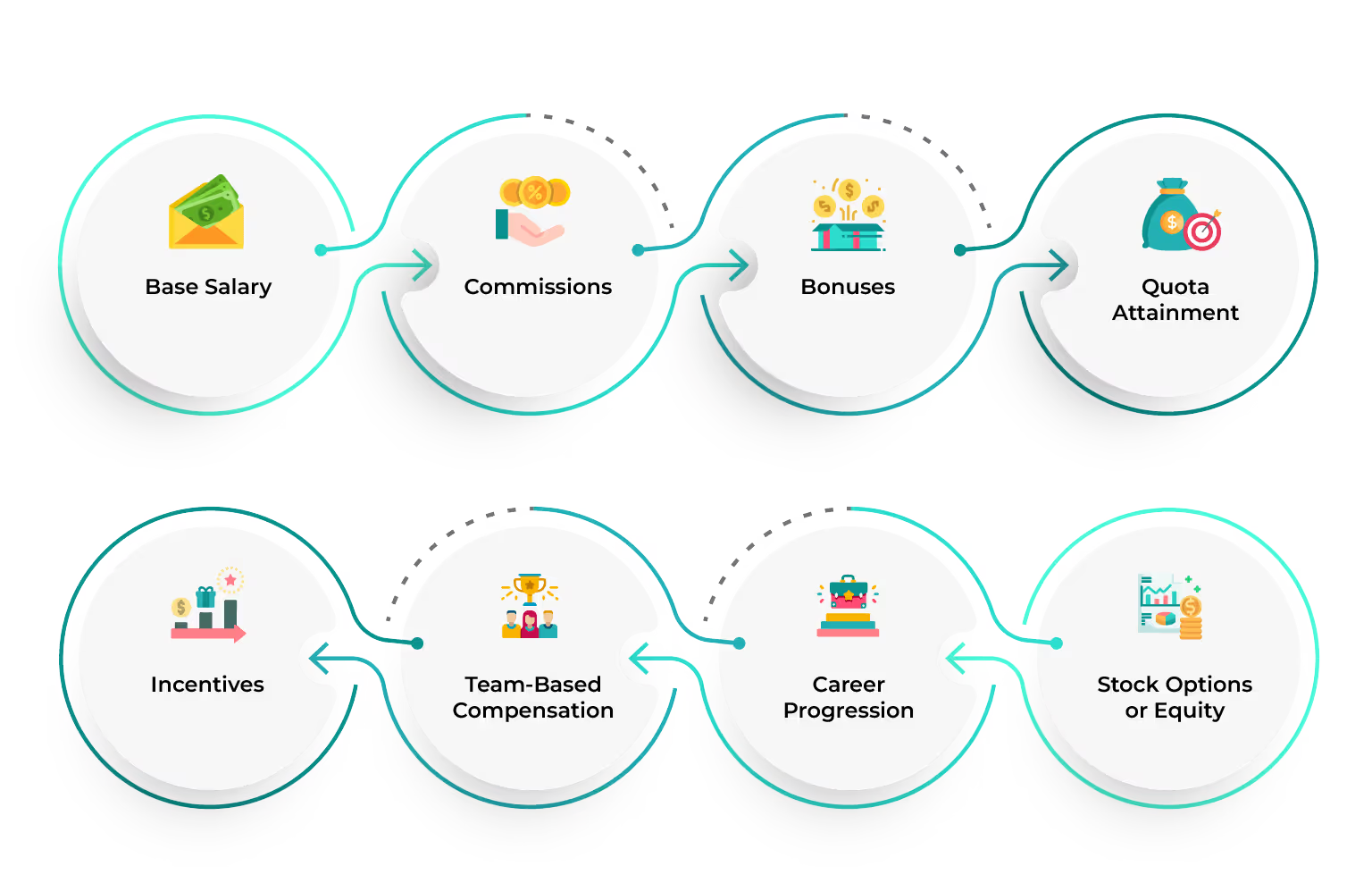
Blog
Unlocking Success: A Comprehensive Guide to SDR Compensation Strategies
October 6, 2023


Key Insights
In the ever-evolving landscape of sales and marketing, Sales Development Representatives (SDRs) play a pivotal role in driving revenue and fostering customer relationships.
As the importance of SDRs continues to grow, so does the need to compensate them in a way that aligns with their performance and motivates them to excel. Traditional compensation models are no longer sufficient to meet these demands. In this evolving landscape, broad-based compensation strategies come to the forefront, offering a more comprehensive and adaptable approach.
This blog delves into the world of innovative SDR compensation approaches that are transforming the way organizations reward and motivate their sales development teams.
How are SDRs Compensated?

Sales Development Representatives (SDRs) are typically compensated through a combination of base salary, commissions, bonuses, and sometimes additional incentives.

The specific compensation structure can vary from company to company, but here are some common elements:
- Base Salary: SDRs usually receive a base salary, which provides them with a regular income. This base salary can vary widely based on factors such as the industry, location, and the level of experience of the SDR.
- Commissions: Commissions are a significant part of an SDR's compensation, often forming the basis of their OTE compensation package. They are typically awarded based on the successful completion of certain sales-related activities, such as setting up meetings or appointments with qualified leads or prospects. The commission rate may vary depending on the company's sales model and the value of the leads generated.
- Bonuses: Some companies offer bonuses to SDRs based on specific performance metrics. These bonuses can be tied to achieving monthly, quarterly, or annual targets, such as meeting a certain number of leads or converting a certain percentage of leads into opportunities.
- Quota Attainment: Many SDRs are given a quota or target to meet, such as a certain number of qualified leads generated or meetings scheduled. If they exceed their quota, they may earn additional commissions or bonuses.
- Incentives: Companies may provide additional incentives to motivate SDRs, such as prizes, recognition, or career advancement opportunities for exceptional performance.
- Team-Based Compensation: Some organizations have team-based compensation structures where the overall performance of the SDR team impacts individual compensation. This can foster a collaborative environment where team members support each other to meet collective goals
- Career Progression: SDR roles can serve as a stepping stone to more advanced sales roles. Some companies offer a clear path for SDRs to advance to Account Executive or other sales positions, which often come with higher compensation.
- Stock Options or Equity: In some tech startups and high-growth companies, SDRs may receive stock options or equity as part of their compensation package, allowing them to benefit from the company's growth and success.
To learn more about how you can maximize performance through commission structures, read this blog.

It's important for SDRs to understand the specific compensation structure and metrics used by their employer, as well as any performance expectations. The compensation package can significantly vary between organizations, so SDRs should negotiate their compensation based on their experience, skills, and their target compensation to ensure a fair and rewarding arrangement.
The Evolution of SDR Compensation:
Historically, SDR compensation has predominantly been based on a fixed salary and commission structure.
While this model has worked well for many organizations, it often fails to fully incentivize SDRs, especially when their roles have become more multifaceted and metrics-driven.
In response to these challenges, innovative compensation approaches have emerged.
Innovative SDR Compensation Approaches:

Outcome-Based Compensation
Outcome-based compensation focuses on rewarding SDRs based on the results they achieve, rather than merely their activities. This approach involves setting specific goals and key performance indicators (KPIs) tied to revenue generation or customer acquisition. SDRs are then compensated based on how well they meet or exceed these goals, often implemented through a straight commission sales structure where earnings are directly correlated with sales outcomes.
The key advantage of this approach is that it directly aligns the SDR's compensation with the organization's strategic objectives. It encourages SDRs to focus on high-value activities that are most likely to result in closed deals, rather than simply making a high volume of calls or sending numerous emails.
Team-Based Compensation
In contrast to the traditional individual-centric compensation model, team-based compensation promotes collaboration and teamwork among SDRs. Instead of solely rewarding individual achievements, a portion of the compensation is tied to collective performance metrics, such as team quotas or conversion rates.
Team-based compensation fosters a sense of camaraderie and shared responsibility among SDRs. It encourages them to support one another, share best practices, and work together to achieve common goals. This approach is particularly effective in organizations where complex sales cycles require a coordinated effort among SDRs. Implementing effective incentive compensation management solutions tailored to team performance can further reinforce collaboration and drive desired outcomes, ultimately enhancing the overall effectiveness of the sales development team.
Holistic Compensation Packages
A more holistic approach to SDR compensation takes into account various aspects of an SDR's job, including professional development opportunities, recognition programs, and non-monetary incentives, showcasing the benefits of MBO. These packages recognize that SDRs are motivated by more than just money; they value career growth, recognition, and a positive work environment.
By offering a comprehensive compensation package, organizations can attract and retain top talent while ensuring that SDRs remain engaged and motivated in their roles. This approach is particularly beneficial in highly competitive job markets where SDR turnover can be a significant challenge.
Technology-Enhanced Compensation Models
The advent of advanced sales technologies and analytics has opened new possibilities for SDR compensation. Some organizations are leveraging AI-driven tools to track and measure SDR performance more accurately. These tools can provide real-time insights into prospect engagement, conversion rates, and revenue contribution.
By integrating technology into compensation models, organizations can create dynamic, data-driven incentive structures. For example, SDRs might earn bonuses for adopting new technologies that boost their productivity or for achieving specific benchmarks in their CRM systems, enhancing their motivation and alignment with company goals.
Implementing Innovative SDR Compensation:
While these innovative SDR compensation approaches hold promise, they are not one-size-fits-all solutions. Implementing them effectively requires careful consideration of the organization's unique goals, culture, and resources.
Here are some steps to consider when adopting innovative compensation models:
- Align with Strategy: Ensure that the chosen compensation approach aligns with the overall business strategy and objectives. It should incentivize behaviors that drive the organization toward its goals.
- Clear Communication: Transparent communication is crucial. Clearly outline the sales compensation plan, how it works, and the expectations for SDRs. Make sure everyone understands the new model and its benefits.
- Continuous Evaluation: Regularly assess the effectiveness of the compensation approach. Collect feedback from SDRs and adjust the model as needed to address any challenges or concerns.
- Flexibility: Be prepared to adapt. The sales and marketing landscape is dynamic, and what works today may not work tomorrow. Be open to refining and iterating on the compensation model to stay competitive and effective.
- Training and Development: Invest in training and development programs to help SDRs improve their skills and meet performance targets. This not only benefits individual SDRs but also contributes to the overall success of the organization.
For SDRs in the SaaS industry, know more about SaaS sales compensation benchmarks with SaaS sales compensation benchmarks at 15 Sales Compensation Benchmarks to Use
In Conclusion:
Innovative SDR compensation approaches are reshaping the way organizations motivate and reward their sales development teams.
Whether it's outcome-based compensation, team-based incentives, holistic packages, or technology-enhanced models, the key is to find the approach that aligns with your organization's goals and culture.
By doing so, you can not only attract and retain top talent but also drive revenue growth and ensure the long-term success of your sales development efforts.
As the sales and marketing landscape continues to evolve, so too must your approach to compensating the dedicated professionals who drive your business forward. This adaptation should consider incorporating a marketing automation strategy that aligns with the dynamic and data-driven nature of contemporary sales and marketing efforts.
ReKennect : Stay ahead of the curve!
Subscribe to our bi-weekly newsletter packed with latest trends and insights on incentives.
Thank you! Your submission has been received!
Oops! Something went wrong while submitting the form.
Your data is in safe hands. Check out our Privacy policy for more info














